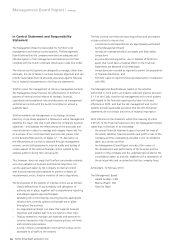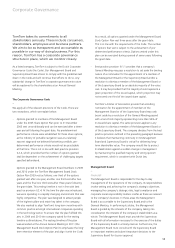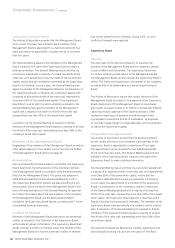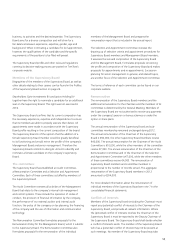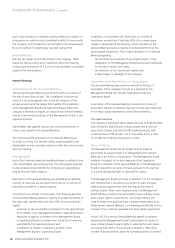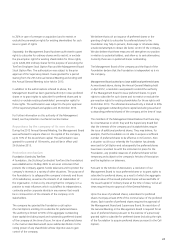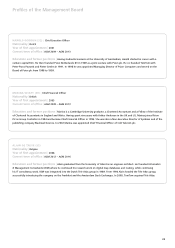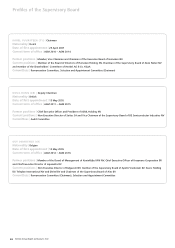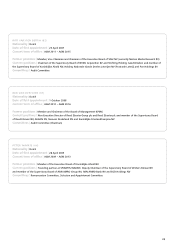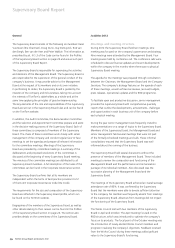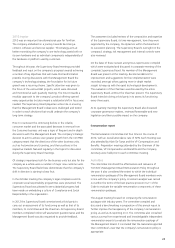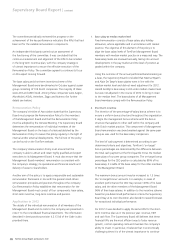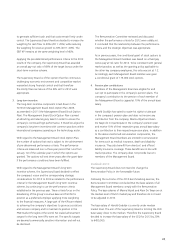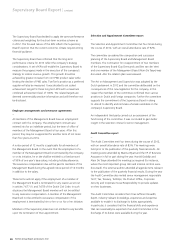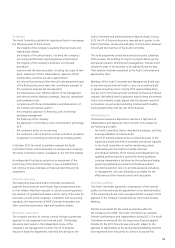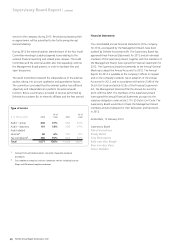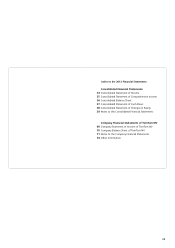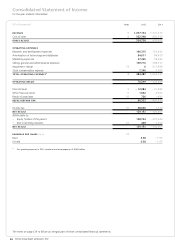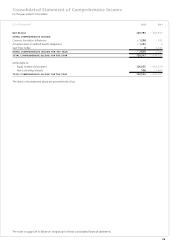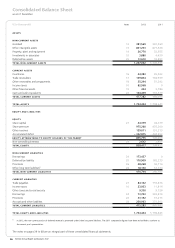TomTom 2012 Annual Report Download - page 28
Download and view the complete annual report
Please find page 28 of the 2012 TomTom annual report below. You can navigate through the pages in the report by either clicking on the pages listed below, or by using the keyword search tool below to find specific information within the annual report.TomTom Annual Report and Accounts 2012
26
Supervisory Board Report
General
—
The Supervisory Board consists of the following six members: Karel
Vuursteen (the Chairman), Doug Dunn, Guy Demuynck, Rob van
den Bergh, Ben van der Veer and Peter Wakkie. The information as
prescribed by art. III.1.3 of the Code can be found in the Profi les
of the Supervisory Board section on page 24 and are as such part
of this Supervisory Board Report.
The Supervisory Board is responsible for supervising the activities
and decisions of the Management Board. The Supervisory Board is
also responsible for the supervision of the general conduct of the
company’s business. It may provide advice to the Management
Board at the request of its members and on its own initiative.
In performing its duties, the Supervisory Board is guided by the
interests of the company and its businesses, taking into account
the interests of TomTom’s stakeholders as a whole and at the
same time applying the principles of good entrepreneurship.
The key elements of the role and responsibilities of the Supervisory
Board are set out in the Supervisory Board rules and can be found
on the TomTom website.
In addition, the Audit Committee, the Remuneration Committee
and the Selection and Appointment Committee prepare and assist
in the decision-making process of the Supervisory Board. Each of
these committees is composed of members of the Supervisory
Board. The chairs of these committees work closely with senior
management of the company and conduct regular face-to-face
meetings to set the agendas and prepare all relevant information
for the committee meetings. Meetings of the Supervisory
Board are preceded by committee meetings. A summary of the
deliberations and proposed resolutions of the committees is
discussed at the beginning of every Supervisory Board meeting.
The minutes of the committee meetings are distributed to all
Supervisory Board members. A full description of the tasks of the
committees can be found in the Corporate Governance section.
The Supervisory Board confi rms that all its members are
independent within the terms of best practice provision III.2.2
of the Dutch Corporate Governance Code (the Code).
The requirements for the size and composition of the Supervisory
Board are refl ected in the Supervisory Board profi le, which can
be found on the TomTom website.
Biographies of the members of the Supervisory Board, as well as
other details relating to their careers can be found in the Profi les
of the Supervisory Board section on page 24. The section also
provides details on the committees of the Supervisory Board.
Activities 2012
—
Meetings and meeting structure
During 2012 the Supervisory Board held ten meetings. One
meeting was focused on the company’s governance and strategy.
Nine meetings were attended by the Management Board. Four
meetings were held by conference call. The conference calls were
scheduled to discuss fi nancial updates and recent developments
within the company in the months when there was no physical
Supervisory Board meeting.
The agenda for the meetings was prepared through consultation
between the Chairman, the Management Board and the Company
Secretary. The company’s strategy features on the agenda of each
of these meetings, as well as fi nancial reviews, (annual) budgets,
press releases, operational updates and the R&D programme.
To facilitate open and productive discussion, senior management
provides the Supervisory Board with comprehensive quarterly
reports that outline the developments, achievements, challenges
and opportunities in each business unit of the company before
each physical meeting.
During the year senior management was frequently invited to
make presentations on a range of topics to the Supervisory Board.
Members of the Supervisory Board, the Management Board and
senior management held several meetings that were not part
of the formally scheduled meetings and calls. These informal
consultations ensured that the Supervisory Board was well
informed about the running of the business.
The Supervisory Board held several discussions without the
presence of members of the Management Board. These included
meetings to review the composition and functioning of the
Management Board and the performance and remuneration
package of its individual members. Also discussed was the
succession planning of the Management Board and the
Supervisory Board.
The meetings of the Supervisory Board achieved an overall average
attendance rate of 85%. It was confi rmed by the Supervisory
Board that the members were able to devote suffi cient attention
to the company. No member was frequently absent from meetings
of the Supervisory Board. Absences from meetings did not impact
the functioning of the Supervisory Board.
The Works Council met with two members of the Supervisory
Board in April and October. The April meeting focused on the
R&D structure, which was introduced to optimise the company’s
focus on its products. The focal point of the October meeting was
the introduction of newly elected Works Council members and
progress in realising the company’s objectives. Feedback received
from the Works Council during these meetings adds signifi cant
value to the Supervisory Board’s functioning.


